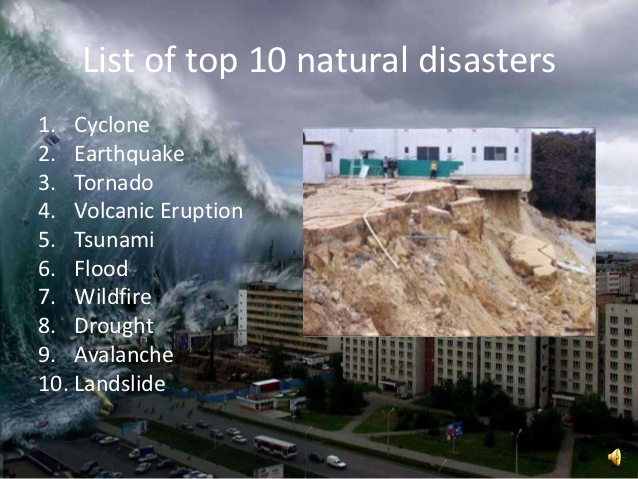
We live on a volatile planet. The earth’s crust is constantly shifting which changes land formations, forms mountains, volcanoes, earthquakes, and tsunamis. Additionally the wind may form into cyclones and tornadoes while water sources such as lakes, rivers, streams, creeks, ocean harbors, and rain all may contribute to flooding. Droughts may contribute to wildfires. Heat and erosion may contribute to avalanches and landslides. When events like these collide with humans, the results can be deadly. Despite it all, we all call planet Earth home.
We are fortunate that in most areas of the US there are weather and disaster warning systems. If we are paying attention, we should at least have some warning and hopefully be able to make wise decisions in precious little time that can save lives and minimize casualties. Beyond this, there are things we can do to prepare for the unexpected. Being prepared is one of the best ways to give yourself peace of mind and buy precious time in the event of an actual emergency. One thing you will definitely want to have is a back up supply of food, water, pet supplies, necessary pharmaceuticals and toiletry items. You can see a detailed list of things you may need in my post on Terrorism.
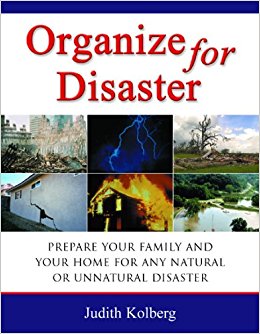
In addition to the same type of things needed in the event of a terrorist attack, Organize for Disaster by Judith Kolberg covers most natural disasters (also some man made ones) and gives specific suggestions as to how you can prepare. Of course many of the preparations will work for multiple events. Being well prepared for various disaster scenarios involves more than just stock piling food and personal items. Judith Kolberg suggests that you also have clothing (at least one change of clothing for each member of your household), blankets and/or sleeping bags, a well stocked first aid kit, extra tennis shoes and/or boots (waterproof would be best). It is also recommended that you have both a landline phone and a cell phone. A small portable radio and flashlights should also be readily available.
If you are fortunate enough to have the space (perhaps in a basement or garage) you can set up a disaster provision area. Pet carriers and emergency pet supplies should also be stored in this area.
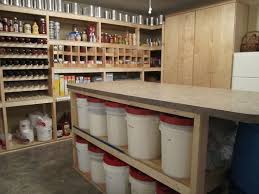

If you are not so fortunate to have such space luxury there are still things you can do. Here is an excellent way to pack a lot into a small space. You might consider doing one for each family member.
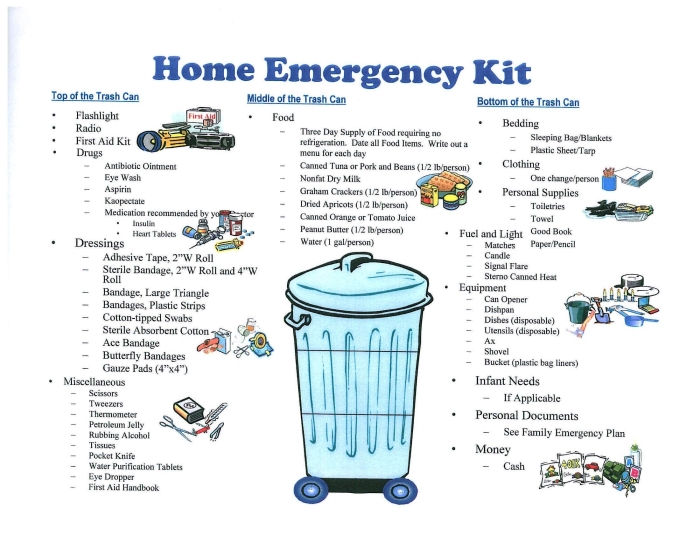
It would be best if you used a waterproof trashcan on wheels since you may have to leave your home on foot. Wheels would obviously make it easier to transport supplies if needed.
If you are leaving your home to go to an emergency shelter you wouldn’t need to take something the size of a trashcan. A shelter should have its own stock of those sorts of supplies. Judith Kolberg recommends having a prepacked “grab and go bag.” For those of you with military backgrounds, this is basically the same thing as a bug out bag. Judith recommends having these bags stored in an easily accessible place. There should be one bag per family member (including pets) and each bag should be labeled by family member name. Weather appropriate coats, jackets, and sweaters should be stored close to these bags. Judith’s book suggests using backpacks hung on coat hooks with weather gear stored directly below them on another row of coat hooks. Some shelters will not take animals so be sure that you have a previously thought out plan about where your pets will go to get to safety. Other shelters DO allow pets so if a temporary emergency shelter is part of your plan, find out in advance the shelter’s pet policy. If you are going to a hotel, you should also find out the pet policy well in advance. Many hotels are becoming more animal friendly.
If you need to bug out and you will be taking pets with you, here are some examples of what you may need:
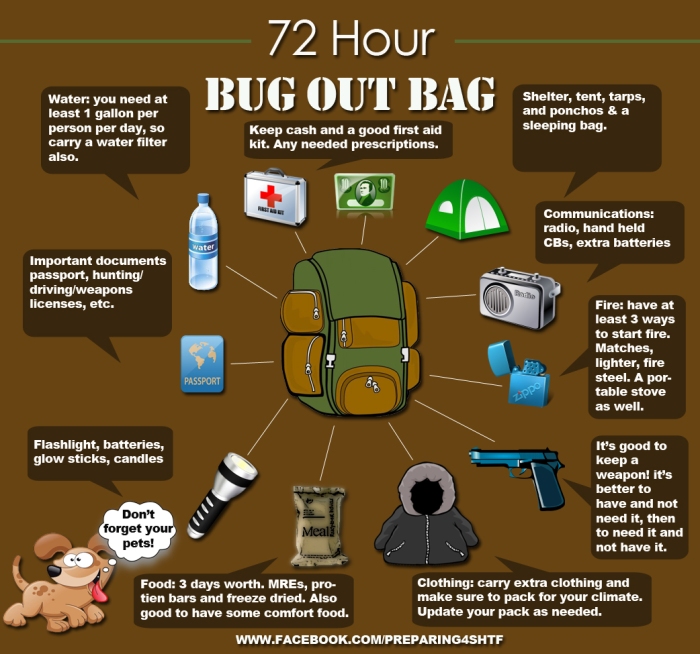
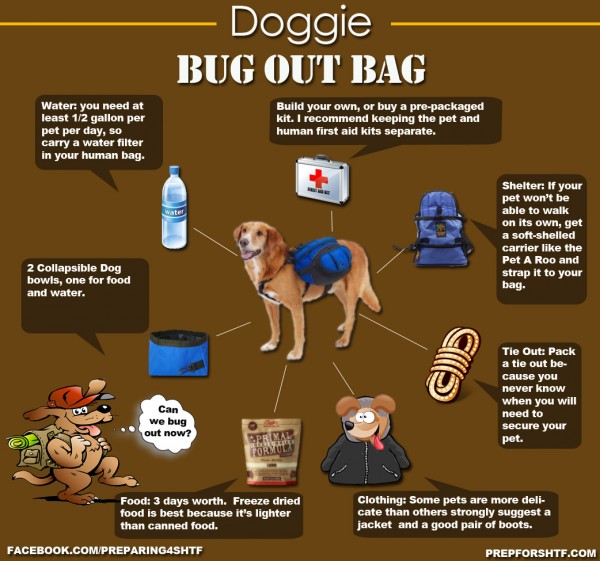

Check to see if your cat still fits! You may need to purchase a small soft sided cat carrier that can be worn and then use the carrier at your destination to secure your cat.
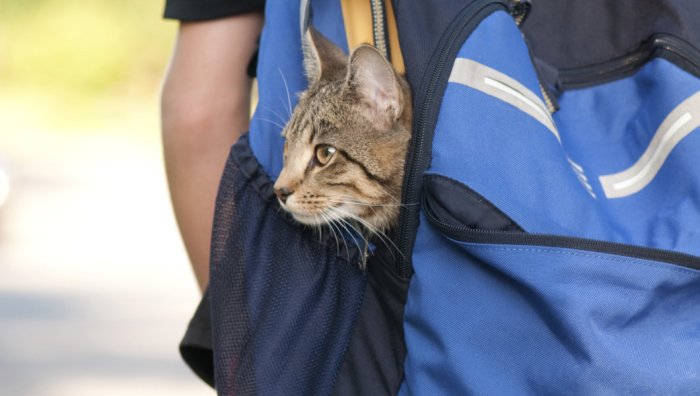
If you need to bug out with small pets, birds, fish, snakes, reptiles, etc. think along the guidelines listed above. Birds should have a light cover over their cage during movement. Be sure that the cover allows air and light into the cage. Small animals will require housing, food, water, toys, bedding, treats, etc. Fish will be more challenging. You may want to have a previously established emergency tank set up within a safe distance (for instance in a friends garage, basement, or shed with access to electricity in a nearby town or another part of the city that doesn’t flood). The emergency tank should be filled from the same water source you use for your tank at home. Be sure to have plenty of food, necessary water conditioners and stress reducing products stored here. If at all possible try to give yourself enough time to acclimate your fish to the emergency tank. If you must keep moving and can’t acclimate the fish yourself, be sure you have previously taught your friend how to acclimate fish–and leave written instructions near the tank as a reminder. Have emergency transfer nets and carriers available. Fish can be transferred in almost any nonmetal clean container that holds water. Bear in mind that while you want your fish to be able to move freely about, you won’t want to completely fill the container–fish still need oxygen. Also, make sure the container has a lid (fish can jump out) with air holes.
If you must leave your home due to an emergency, no pets should ever be left behind. Having a previously thought out plan will make evacuating much smoother and less stressful.
In addition to all of the above preparations there are also several other things that you should arrange prior to needing them:
Your Family Plan– You should have escape routes well thought out for various scenarios and possibilities. Each family’s plan will be different from another family’s. For instance, I live in Indiana and it is highly unlikely that I would ever need to evacuate due to a tsunami (unless on vacation). However, you may live on the coast and need to plan for that possibility.
Your family needs a communication plan. Phone numbers should be in your phone and also written and stored in your bug out bag for easy access. Cell towers may be down, but if you can make it to a landline you may be able to make any necessary phone calls. Also, if calls are not going through, always check and see if texting will work. If you use a prepaid phone, be sure every member of your family has emergency minute cards (prior to the emergency-these would be packed in your bug out bags.) Taking a tablet or ipad with you for communication is an excellent idea if the internet is functional. Don’t forget chargers and accessories.
Have at least two places to meet each other if you should become separated. You need more than one location. For example if you have left your home due to flooding and your plan was to meet in front of the court house but the court house is also flooded you would have a problem if you became separated and phones are down. Since you were well prepared though, everyone in your family knows the alternate location is to meet at the library. You can make as many locations as you want. It is a good idea to write this plan down and have it in everyone’s bug out bag. When people are under stress they may not remember even simple plans, but again because you are well prepared everyone knows exactly what to do and where to go.
Your Essential and Important Documents-Organize anything you would need to reestablish services, file insurance claims, prove identity, etc and all irreplaceable items such as treasured family photos, etc. Most survivalists recommend putting these documents in light weight containers such as plastic freezer baggies that will protect them from water. All of your family photos can be taken with you easily by having them scanned onto a flash drive and stored in a freezer baggie in your bug out bag. If needed, they can be reprinted at a later date. It’s also a good idea to scan in all of your important documents although you may still need some of the originals with you like your driver’s license or ID card and your Social Security card. In most cases, one flash drive can handle all of this–and more. By scanning in all of your important documents you will have all your account numbers and other important information available to you. Always have your flash drive backed up to a disc or other device.
Insurance-Insurance coverage should be arranged now while there is time to do it correctly. Do you live in a flood zone? Have you checked if your home owner’s policy covers flooding? If a tree falls on your roof during a tornado, will your policy cover it? Don’t forget to check on things like cars, boats, lawn mowers, and basically anything it would be expensive to pay for repairs or to replace. Do not just assume that certain events are covered. Ask specific questions and find out what all is covered. I once went in for an insurance review on my car. The insurance agent said something like my policy only covered anything that was on wheels. In other words, he said, if a deer jumped out of the woods and hit my car (and that does happen in my area) it wouldn’t be covered because something with wheels didn’t strike me. I asked him about horses (there are a lot in my area) and he told me that horses were not covered. Then I asked him what if the horse was attached to a buggy (There are a lot of Amish horse drawn buggys in my area.) The agent looked puzzled and said, “I don’t know. No one has ever asked me that!” I made some changes to my policy.
Home Furnishings– It is a good idea to do a home inventory documented with photos and/or videos. This can be invaluable in helping you replace items in the event a natural disaster completely destroys everything in your home. (Things can be replaced, but people can’t.) This information can be included on your flash drive, phone, or other device. Again, always back up your important information.
In the book Disaster Preparedness:Ready Yourself, Your Family, and Your Home-Before Disaster Strikes by Rod Brouhard, EMT-P and Crystal Kline, MEP the authors cover all of the topics listed above but they have also included many helpful checklists to help you prepare. The checklists make this book worth checking out.
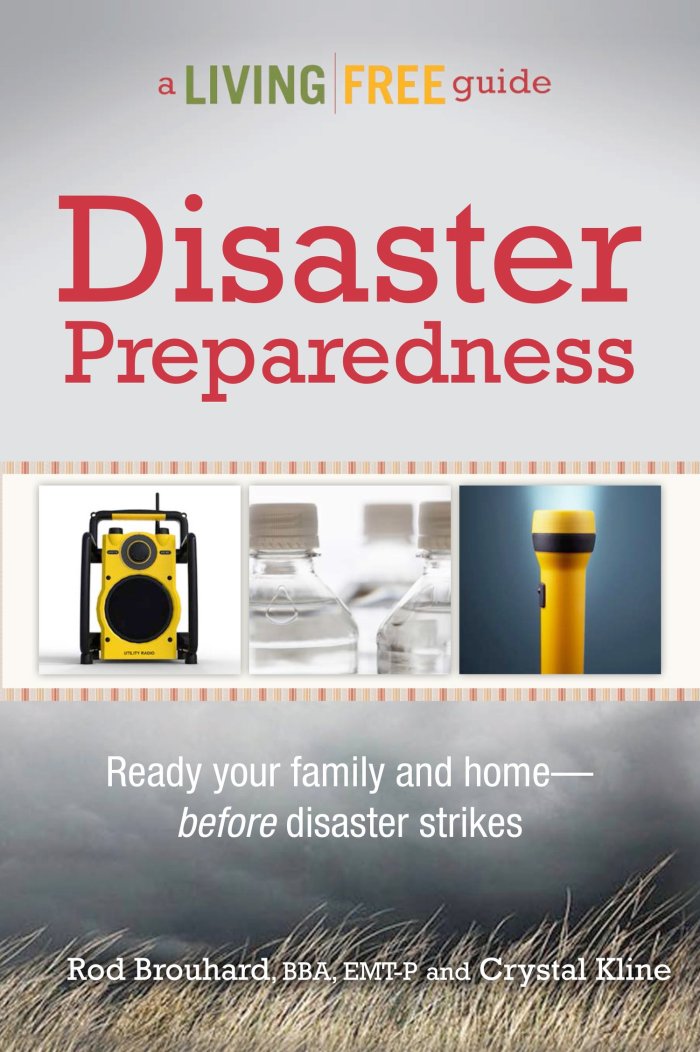
If you are unsure what to do in a particular weather (or man made) emergency, there are may books that describe weather and natural phenomenon and what to do. It is a good idea to acquaint yourself with these types of books now. Here are a few of the ones I looked at:
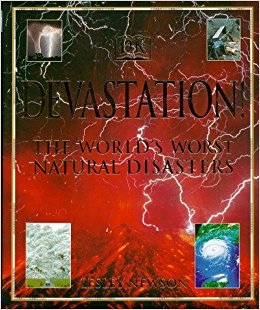
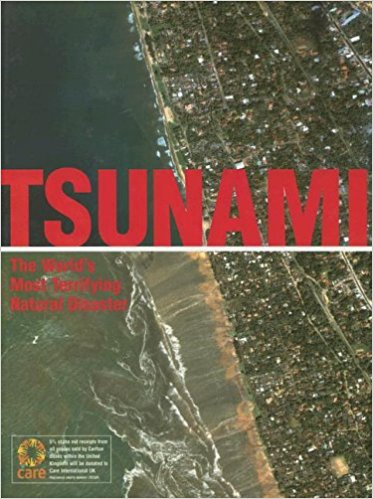

The three books above are pretty amazing picture books. There is also great information in all three.
Do you have any experience with natural disasters? Do you have friends and family who have had to deal with severe weather phenomenon? What will you do to prepare for the possibility of extreme weather and natural events?

Super excellent!!!! I even read some of it to Terry the Quilting Husband as we have our breakfast this morning. I love the pet related info and this whole post is so well done! Thanks for the info!!!
LikeLiked by 2 people
Thank you. I’m pleased that you found it helpful.
LikeLiked by 2 people
I forgot to ask if you are working on that Doggy Bug Out Bag now! 😉
LikeLiked by 2 people
Maybe it is a very good idea🙂
LikeLiked by 1 person
Another amazing post, very in depth! I just posted about my water stock piling haha.
I don’t think I know of anyone, at least not that has talked to me about it, that has had to deal with something that severe. I do however try to stay as prepared as I can. I have a bug out bag, and practice with it when I go out camping, I got a nice 30+ Liter bag and have everything I would need in it other than my gun and passport, which I would grab if need be.
LikeLiked by 2 people
That’s probably far more prepared than most people!
LikeLiked by 2 people
I hope so! I’ve been racking my brain, trying to make sure that I have helped my self and wife as much as I can before this all goes down lol.
LikeLiked by 1 person
BTW, just in case you need useless trivia knowledge, the military calls aBug Out Bag a BOB. LOL. Good to know BOB goes with you camping!
LikeLiked by 1 person
Running trash cans are an excellent idea, that I never would have thought of!!
I’ve lived thru 4 of your list. I would have thought hurricanes would be on there. I guess they’re #11!
LikeLiked by 1 person
Wow. Which 4 have you experienced? Do you have further advice for everyone?
LikeLiked by 1 person
Volcano, earthquake, while first husband was posted in Alaska.
Wildfire, and drought here in my native Florida. I haven’t been inside the wildfire, but drove near, and immediately after one, while the ground was still smoking.
Carry water and snacks!!
Be a praying person!
LikeLiked by 1 person
Thank you for sharing. Those must have been terrible experiences.
LikeLiked by 1 person
Since we survived unharmed, it’s all good!!
LikeLiked by 1 person
There are even fewer natural disasters in the UK – we’re lucky. Flooding, and storms seem to be the biggest difficulty.
I am so pleased you thought about cats and dogs!
LikeLiked by 1 person
Thank you. I have a pretty big soft spot for our furry friends!
LikeLike
This is a topic I haven’t thought about since I was a child. We had a basement with a cabinet with supplies in case of emergencies.
Many people disregard the need for such prearrangements. I believe it is so much wiser to prepare WITH NECESSARY PROVISIONS, than pretend catastrophes don’t occur and be devastated by their merciless destruction.
Great reminder for all of us. Thanks for the detailed recommended provisions.
LikeLiked by 1 person
Yes, I believe it’s wise to prepare. It’s so much better to prepare and not need to have done so than to need that preparation and not have it.
LikeLiked by 1 person
Very good info. A year or 2 ago I put together a disaster kit with canned food, medical supplies, etc, and had an oddly fun time putting it all together. (I’m into organizational stuff like that.) Hopefully I’ll never have to use it but I feel better knowing it’s there.
LikeLiked by 1 person
That’s great! I’m so glad you have taken some precautions.
I also like the actual organizing of things. I’m currently doing the KonMari method in my home. I’m on papers–and will be for some time. We have almost completed 1/4 of our home/property in the papers category. I can’t wait to get to those types of books in my read through!
LikeLiked by 1 person
What is the KonMari method?
LikeLiked by 1 person
Oh my! You have GOT to learn about KonMari! It’s like organizational heaven! To start with you will need to read Marie Kondo’s book, The Life Changing Magic of Tidying Up: the Japaneese Art of Decluttering and Organization.
You can also just type in KonMari into a search engine and all sorts of pictures will appear to give you ideas. Basically, Marie Kondo says that you need to get rid of clutter and only keep those things that bring you joy. Once the clutter is gone, the organization is possible. Everything that gets done, STAYS done. When I first heard that I thought that’s way too good to be true…but I’ve been doing it and it’s true!
I work quite a bit slower than recommended due to caring for other family members, but essentially you begin the decluttering/organization in a specific order: clothes, books, papers, komono (this is a misc. category that encompasses anything that doesn’t fit in the other categories), and memoriabilia. I’m am currently working on papers.
When you see the pics/read the book (which is small and a very easy read) please let me know what you think.
I should mention that there is a lot of Hinduism in the book, but I personally don’t do that aspect. I am grateful for what I have but I don’t necessarily talk to objects like they have humanistic qualities. Still, it’s a fantastic system and I can’t wait to find out what you think about it!
LikeLike